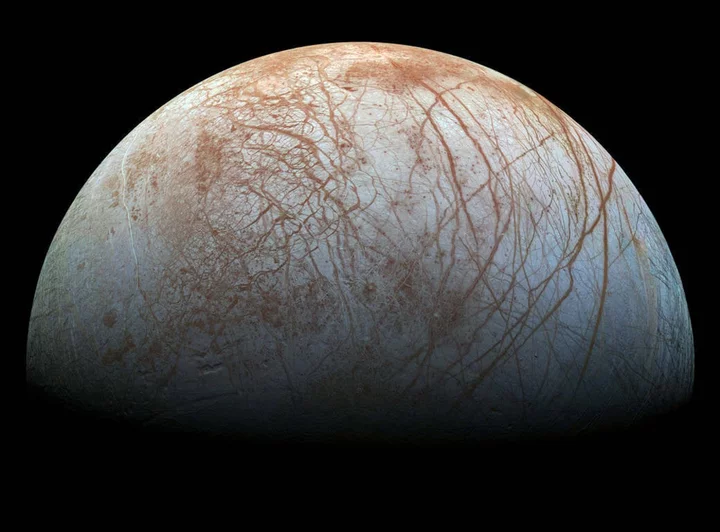There are few places in our solar system more intriguing than Europa.
Beneath its cracked icy shell, NASA and planetary scientists suspect this Jupiter-orbiting moon harbors a giant sea, some 40 to 100 miles deep. Now, new observations from the powerful James Webb Space Telescope show a region on Europa's surface contains carbon dioxide, an important ingredient for life as we know it.
The find isn't nearly evidence of actual life, but it makes the ocean world an even more compelling place to further explore.
"We now think that we have observational evidence that the carbon we see on Europa’s surface came from the ocean. That's not a trivial thing. Carbon is a biologically essential element," Samantha Trumbo, a planetary scientist at Cornell University who analyzed the Webb telescope data, said in a statement. (Nearly one-fifth of the human body is composed of carbon, for example.)
SEE ALSO: High-speed object just crashed into Jupiter, footage showsOn Europa's cracked surface, the carbon dioxide is most concentrated in a region with a relatively young, irregular surface, dubbed Tara Regio, which means "chaos terrain." The legendary Hubble Space Telescope had previously spotted salt in Tara Regio. "Now we’re seeing that carbon dioxide is heavily concentrated there as well," Trumbo explained. "We think this implies that the carbon probably has its ultimate origin in the internal ocean."
The images below show how Webb, which orbits the sun 1 million miles from Earth, viewed Europa. Scientists used the telescope's Near-Infrared Spectrograph, or NIRSpec, a type of instrument that acts similar to a prism, to find the carbon. A spectrograph splits the light it receives into a rich spectrum of colors, revealing the elements present in a distant object.
The first image on left is an infrared Webb image of the distant moon, while the next three views are from its spectrograph:
The three images on right show where the Webb telescope identified carbon dioxide on Europa. The white regions at center-right depict the carbon dioxide-rich Tara Regio area. Credit: Geronimo Villanueva (NASA / GSFC) / Samantha Trumbo (Cornell Univ.) / NASA / ESA / CSA. Image Processing Credit: Geronimo Villanueva (NASA / GSFC) / Alyssa Pagan (STScI)Want more science and tech news delivered straight to your inbox? Sign up for Mashable's Light Speed newsletter today.
Europa lies hundreds of millions of miles beyond Earth. But NASA plans to get much closer. In 2024, the space agency plans to launch the Europa Clipper mission, which seeks to "determine whether there are places below the surface of Jupiter’s icy moon, Europa, that could support life," NASA explained. The spacecraft will fly by the moon dozens of times, capturing unprecedented data. In this briny sea, conditions might be suitable for life. Whether it potentially contains some primitive life, however, is another question.
The Webb telescope's powerful abilities
The Webb telescope — a scientific collaboration between NASA, the European Space Agency, and the Canadian Space Agency — is designed to peer into the deepest cosmos and reveal new insights about the early universe. But it's also peering at intriguing planets in our galaxy, along with the planets and moons in our solar system.
Want more science and tech news delivered straight to your inbox? Sign up for Mashable's Light Speed newsletter today.
Here's how Webb is achieving unparalleled feats, and likely will for decades:
- Giant mirror: Webb's mirror, which captures light, is over 21 feet across. That's over two and a half times larger than the Hubble Space Telescope's mirror. Capturing more light allows Webb to see more distant, ancient objects. As described above, the telescope is peering at stars and galaxies that formed over 13 billion years ago, just a few hundred million years after the Big Bang.
"We're going to see the very first stars and galaxies that ever formed," Jean Creighton, an astronomer and the director of the Manfred Olson Planetarium at the University of Wisconsin–Milwaukee, told Mashable in 2021.
- Infrared view: Unlike Hubble, which largely views light that's visible to us, Webb is primarily an infrared telescope, meaning it views light in the infrared spectrum. This allows us to see far more of the universe. Infrared has longer wavelengths than visible light, so the light waves more efficiently slip through cosmic clouds; the light doesn't as often collide with and get scattered by these densely packed particles. Ultimately, Webb's infrared eyesight can penetrate places Hubble can't.
"It lifts the veil," said Creighton.
- Peering into distant exoplanets: The Webb telescope carries specialized equipment called spectrometers that will revolutionize our understanding of these far-off worlds. The instruments can decipher what molecules (such as water, carbon dioxide, and methane) exist in the atmospheres of distant exoplanets — be they gas giants or smaller rocky worlds. Webb will look at exoplanets in the Milky Way galaxy. Who knows what we'll find?
"We might learn things we never thought about," Mercedes López-Morales, an exoplanet researcher and astrophysicist at the Center for Astrophysics-Harvard & Smithsonian, told Mashable in 2021.
Already, astronomers have successfully found intriguing chemical reactions on a planet 700 light-years away, and the observatory has started looking at one of the most anticipated places in the cosmos: the rocky, Earth-sized planets of the TRAPPIST solar system.
The Webb telescope's giant mirror, which captures bounties of light, under construction. Credit: NASA / Chris Gunn








